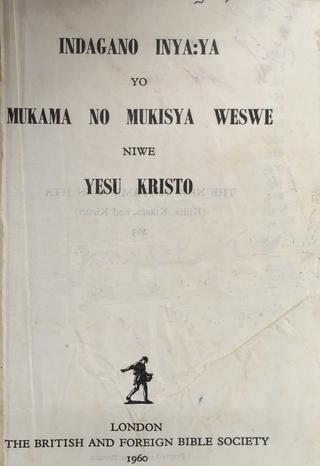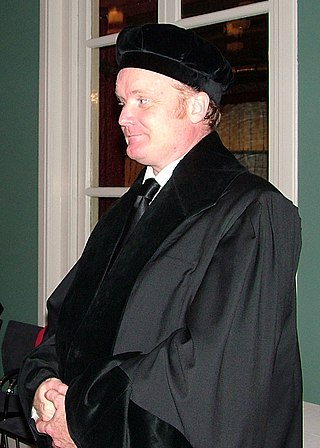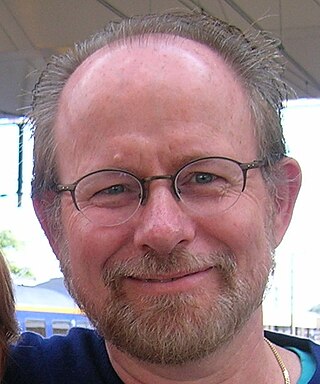Related Research Articles
Phonology is the branch of linguistics that studies how languages or dialects systematically organize their sounds or, for sign languages, their constituent parts of signs. The term can also refer specifically to the sound or sign system of a particular language variety. At one time, the study of phonology related only to the study of the systems of phonemes in spoken languages, but may now relate to any linguistic analysis either:
An iamb or iambus is a metrical foot used in various types of poetry. Originally the term referred to one of the feet of the quantitative meter of classical Greek prosody: a short syllable followed by a long syllable. This terminology was adopted in the description of accentual-syllabic verse in English, where it refers to a foot comprising an unstressed syllable followed by a stressed syllable. Thus a Latin word like íbī, because of its short-long rhythm, is considered by Latin scholars to be an iamb, but because it has a stress on the first syllable, in modern linguistics it is considered to be a trochee.
The voiced alveolar tap or flap is a type of consonantal sound, used in some spoken languages. The symbol in the International Phonetic Alphabet that represents a dental, alveolar, or postalveolar tap or flap is ⟨ɾ⟩.

The voiced labiodental nasal is a type of consonantal sound. The symbol in the International Phonetic Alphabet that represents this sound is ⟨ɱ⟩. The IPA symbol is a lowercase letter m with a leftward hook protruding from the lower right of the letter. Occasionally it is instead transcribed as an with a dental diacritic: ⟨m̪⟩.
Consonant mutation is change in a consonant in a word according to its morphological or syntactic environment.
The Harbin dialect is a variety of Mandarin Chinese spoken in and around the city of Harbin, the capital of Heilongjiang province.
Flapping or tapping, also known as alveolar flapping, intervocalic flapping, or t-voicing, is a phonological process found in many varieties of English, especially North American, Cardiff, Ulster, Australian and New Zealand English, whereby the voiceless alveolar stop consonant phoneme is pronounced as a voiced alveolar flap, a sound produced by briefly tapping the alveolar ridge with the tongue, when placed between vowels. In London English, the flapped is perceived as a casual pronunciation intermediate between the "posh" affricate and the "rough" glottal stop. In some varieties,, the voiced counterpart of, may also be frequently pronounced as a flap in such positions, making pairs of words like latter and ladder sound similar or identical. In similar positions, the combination may be pronounced as a nasalized flap, making winter sound similar or identical to winner.

Jerzy Jan Rubach is a Polish linguist who specializes in phonology. He is a professor of linguistics at the University of Iowa and the University of Warsaw (Poland).
Jeroen van de Weijer is a Dutch linguist who teaches phonology, morphology, phonetics, psycholinguistics, historical linguistics and other courses at Shenzhen University, where he is Distinguished Professor of English linguistics at the School of Foreign Languages. Before, he was Full Professor of English Linguistics at Shanghai International Studies University, in the School of English Studies.

Jita is a Bantu language of Tanzania, spoken on the southeastern shore of Lake Victoria/Nyanza and on the island of Ukerewe.
Derived stems are a morphological feature of verbs common to the Semitic languages. These derived verb stems are sometimes called augmentations or forms of the verb, or are identified by their Hebrew name binyan, and sometimes correspond with additional semantic meaning such as passive or causative action.

Marc van Oostendorp is a Dutch linguist and Esperantist. From 2004 he has served as a weekly commentator on linguistics for Radio Noord-Holland. Since 2007, he has researched phonological microvariation, dialectology and interlinguistics. He is currently attached to the Radboud University in Nijmegen.

Wendy Sandler is an American-Israeli linguist who is known for her research on the phonology of Sign Languages.
Ellen M. Kaisse is an American linguist. She is Professor Emerita of Linguistics at the University of Washington (USA), where she has been affiliated since 1976.

Harry van der Hulst is Full Professor of linguistics and Director of Undergraduate Studies at the Department of Linguistics of the University of Connecticut. He has been editor-in-chief of the international SSCI peer-reviewed linguistics journal The Linguistic Review since 1990 and he is co-editor of the series ‘Studies in generative grammar’. He is a Life Fellow of the Netherlands Institute for Advanced Study, and a board member of the European linguistics organization GLOW.
Ronnie Bring Wilbur is an American theoretical and experimental linguist and a professor of linguistics in the Department of Linguistics, School of Interdisciplinary Studies, College of Liberal Arts, at Purdue University in West Lafayette, Indiana. She also has a joint appointment in the Department of Speech, Language, and Hearing Sciences in the College of Health and Human sciences. Her main focus is sign language linguistics. Some of Wilbur's major contributions to the subfield include the discovery that sign languages have syllables similar to spoken languages and that blinks can be used grammatically to mark clause boundaries. Wilbur is the director of the Sign Language Linguistics Laboratory at Purdue. Research on the cross-linguistic typology of sign languages is a major focus, including Croatian Sign Language (HZJ), Austrian Sign Language (ÖGS), and Turkish Sign Language (TİD).
Monik Charette is a French-Canadian linguist and phonologist who taught at SOAS the University of London, in the United Kingdom. She specializes in phonology, morphophonology, stress systems, vowel harmony, syllabic structure and word-structure, focusing on Altaic languages, Turkish, and French.

Richard Wiese is a German linguist, with academic degrees from the universities of Bielefeld and Düsseldorf. Since 1996, he is a professor of German Linguistics at Philipps-Universität Marburg, Germany, now retired. He has also worked at the universities of Bielefeld, Kassel, TU Berlin, and Düsseldorf.
Elizabeth Cook Zsiga is a linguist whose work focuses on phonology and phonetics. She is a Professor of Linguistics at Georgetown University.
Henk van Riemsdijk is a Dutch linguist and professor emeritus at Tilburg University.
References
- ↑ Hall, T. A. (March 2003). "Colin J. Ewen & Harry van der Hulst , The phonological structure of words: an introduction (Cambridge Textbooks in Linguistics). Cambridge: Cambridge University Press, 2001. Pp. xiii+274". Journal of Linguistics. 39 (1): 201–216. doi:10.1017/S0022226702241985. ISSN 1469-7742.
- ↑ Deterding, David (1 March 2004). "The Phonological Structure of Words: An Introduction". Phonetica. 61 (1): 53–55. doi: 10.1159/000078662 .
- ↑ Gouskova, Maria (May 2013). "Marc van Oostendorp, Colin J. Ewen, Elizabeth Hume and Keren Rice (eds.) (2011). The Blackwell companion to phonology. Malden, Mass.: Wiley-Blackwell. Pp. xxxiii+3106". Phonology. 30 (1): 173–179. doi:10.1017/S0952675713000079. ISSN 0952-6757. S2CID 60678446.